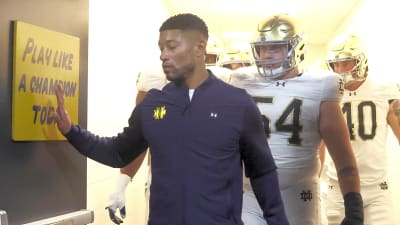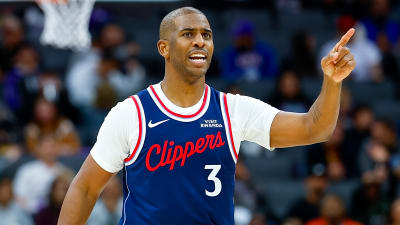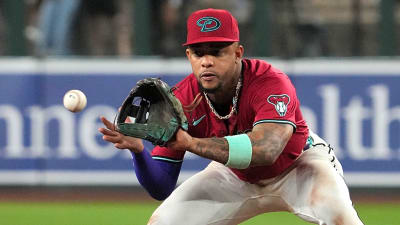
In the 2019-20 season, the Houston Rockets traded away starting center Clint Capela to create micro-ball and become the smallest team in the league. Now, for 2025-26, they’ve brought him back. This time, they’re going to be the biggest. Macro-ball? Mega-ball? The Jumbo Rockets are going big into being big. But will the returns be as big as they blatantly believe?

Clint Capela And Another Mad Rockets Science Experiment
The Houston Rockets are second in ESPN’s offseason power rankings. Obviously, the biggest reason for that is the addition of superstar scorer Kevin Durant. Their second-most prominent addition is probably Dorian Finney-Smith. Meanwhile, their center rotation of Alperen Sengun and Steven Adams was already considered a strength last season. Capela comes in as a replacement for departing third-stringer Jock Landale.
The Rockets’ decision to shell out a three-year, $21.5 million contract to Capela seems bizarre at first glance. The Rockets were already a big team last season. By swapping the six-foot-four Jalen Green for the six-foot-11 Durant, they got even bigger. They even swapped the six-foot-six Dillon Brooks for six-foot-seven Finney-Smith. Durant, Finney-Smith, and Jabari Smith Jr. have all proven themselves serviceable small-ball fives. Last season, Adams was considered overqualified for a backup role. So, what do the Rockets need with yet another starting quality center?
The Udoka Special
Clearly, the front office is interested in experimenting further with head coach Ime Udoka‘s semi-successful postseason strategy. Adams and Sengun played 13.2 minutes per game together in Houston’s series against the Golden State Warriors. They were a +4.6 in those minutes. On one hand, the Rockets had a particular interest in leveraging their physical advantages against a much smaller and older team. On the other hand, one of that team’s smallest and oldest players was Stephen Curry. Curry breaks the rules of basketball. With Curry, the most important part of the basketball court is no longer the bit with the basket in it. Instead, it’s the bit with Curry in it. Or rather, the bit Curry briefly happens to be inhabiting before sprinting off to the new most important part of the court elsewhere. If the Rockets were willing to go double big against Curry, it stands to reason they’d go double big against anyone.
Adding a third starting quality center will allow Udoka to go double-big as much as he wants. He’ll even have options on the bigs in question. Granted, the offense wouldn’t survive Adams and Capela sharing the court, even if defenders would be sent rattling around between screens like pinballs. But either could pair nicely with Sengun for slightly different looks. Unlike the flightless Kiwi, Capela provides a lob threat to add an extra dimension to the big-to-big two-man game.
Capela’s Prime
Off the strength of his lob game, Capela turned himself into one of the better centers in the league during Houston’s title-contending window in the late 2010s. He was a double-double night in, night out. His role in the two-man game with superstar James Harden was clearly the less glamorous and more replaceable of the two. Even so, actually replacing Capela with a more effective player in that specific role would have been nearly impossible at that time. Anthony Davis would have done it better, a superstar and MVP candidate. Other than that? Nobody. Even talk at the time of trading Capela for former first-team All-NBA member DeAndre Jordan was shot down by the front office. Capela was the best lob threat five-man in the league.
Now, hinted at by Jordan having made first-team All-NBA, it was an infamously weak era for NBA centers. Davis was hands down the best, but he only wanted to play power forward. The league was undergoing its spacing revolution at the time, a revolution that Capela and the Rockets were at the Robespierre/Luthen Rael heart of.
In fact, the Capela trade is something of an inflection point in that revolutionary process. It was when the Rockets finally traded Capela for Robert Covington that small ball was deemed to have gone too far. In Capela’s absence, the Rockets’ center rotation was effectively a combination of the six-foot-seven Covington, six-foot-five PJ Tucker, six-foot-eight Jeff Green, and, offensively, the six-foot-four Russell Westbrook. It was micro-ball, and it lasted two playoff series before it got squashed by Davis and LeBron James‘ gigantic Los Angeles Lakers.
Capela since Leaving the Rockets
In Capela’s five seasons with Atlanta since the Rockets trade, he has averaged 11.8 points, 11.3 rebounds, 1.4 blocks, and 2.2 fouls per game. However, in 2024-25, that was down to 8.9 points, 8.5 rebounds, 1.0 blocks, and 1.9 fouls per game. The changes in his per-36 minutes averages were less dramatic. However, he did convert on his lowest percentage from the field since his rookie season. But 55.9% is still more than serviceable.
There’s no question that Capela isn’t at the same athletic peak he was when last with the Rockets. He and Adams both have availability concerns as well. Capela played 55 games last season, Adams 58. They’ll inevitably split back-to-backs in a vein that may remind Rockets fans of Nene and Tarik Black in 2017-18.
The Last Word
The 2025-26 Houston Rockets are going to be the biggest, most physical team in the NBA. A whole gaggle of Frankenstein’s monsters, they will clobber opponents for offensive rebounds, bully drivers in the paint, and run over teams in transition. The Rockets’ 2019-20 microball experiment of trading Capela away blew up in their face. Now he’s back, and in October, their 2025-26 experiment will begin. Whatever happens, you won’t need a microscope to see if it worked.
More must-reads:
- Dynamic dozen: Ranking NBA's best 25-and-under cores
- NBA panic meter: LeBron, Cavaliers, Pelicans, more teams hit crisis mode early in 2025-26 season
- The 'Most passing yards by an NFL rookie' quiz
Breaking News
Trending News
Customize Your Newsletter
 +
+
Get the latest news and rumors, customized to your favorite sports and teams. Emailed daily. Always free!








